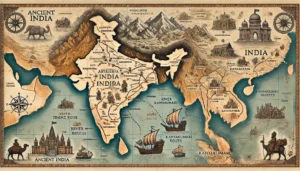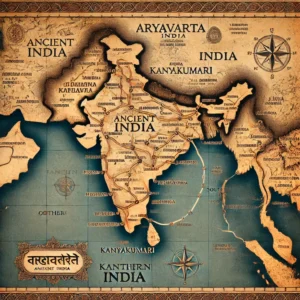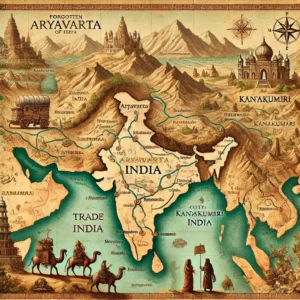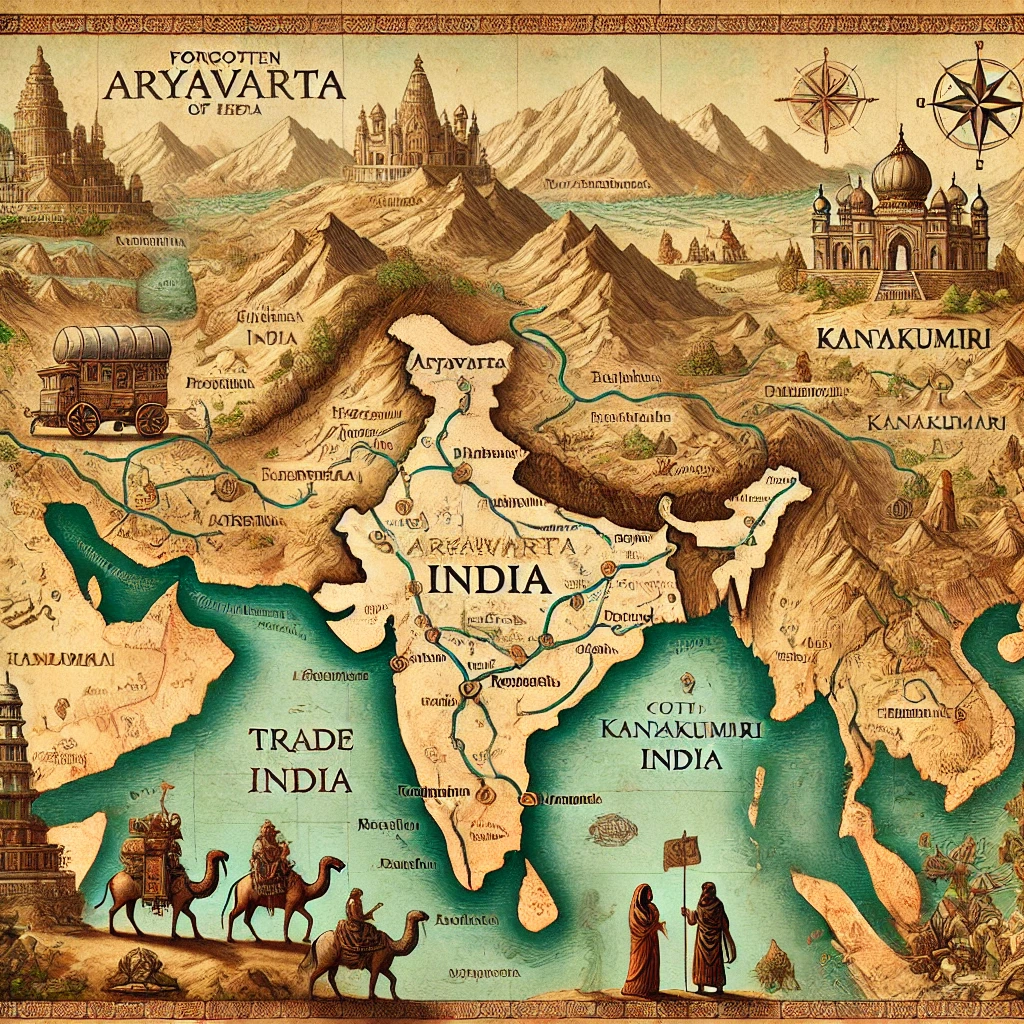
The Forgotten Routes of Ancient India
The Forgotten Routes of Ancient India: From Aryavarta to Kanyakumari
India, a land of ancient wisdom and profound heritage, was once connected by an intricate network of routes that facilitated trade, culture, and spiritual exchanges. These forgotten routes, spanning from Aryavarta in the north to Kanyakumari in the south, shaped the subcontinent’s historical and cultural fabric. These routes were not just pathways of commerce but also conduits for knowledge, art, and religious ideologies, influencing societies across time and geography.
The Grand Northern Highways
In ancient India, the land known as Aryavarta (the land of the noble ones) covered much of present-day North India. This region was connected by the famed Uttarapatha, an ancient highway that linked Gandhara (modern-day Afghanistan-Pakistan region) to the Gangetic plains. It extended further east to the great cities of Varanasi, Pataliputra, and Tamralipti, a significant port that facilitated maritime trade.
The Uttarapatha was not merely a trade route but also a channel for the dissemination of Vedic traditions, Buddhist teachings, and administrative governance. It was used by legendary figures like the Mauryas, Guptas, and foreign travelers such as Fa-Hien and Xuanzang, who recorded its significance. Alongside trade, the route also witnessed the flourishing of ancient centers of learning such as Takshashila and Nalanda, which became beacons of knowledge, attracting scholars from across the world.
Dakshinapatha: The Southern Artery
Complementing the Uttarapatha was Dakshinapatha, a vital route that ran southwards from the Vindhya ranges into the Deccan plateau and beyond. This path connected cities like Ujjain, Pratishthana (modern Paithan), and Kanchipuram before stretching further to Rameshwaram and Kanyakumari. The route was pivotal in the spread of Jainism, Buddhism, and later Bhakti movements, facilitating the exchange of ideas between the north and south.
Ancient Tamil texts, such as the Sangam literature, mention trade with the Romans, Greeks, and Southeast Asians through port cities like Puhar (Kaveripattinam) and Muziris (modern-day Kerala). These southern ports were connected to Dakshinapatha, making it an essential artery of economic and cultural exchange. The rich Tamil and Dravidian cultural traditions flourished along this path, merging with influences from the north to create a unique and vibrant cultural synthesis.
Table of Contents

The Forgotten Routes of Ancient India
The Maritime Spice Routes
India’s ancient routes were not limited to land; maritime highways played a crucial role in trade and diplomacy. The Spice Route connected Indian ports with Persia, Arabia, and the Roman Empire, making the subcontinent the world’s leading supplier of spices, textiles, and precious stones.
Kanyakumari, located at the southern tip of India, served as a confluence of maritime routes. Indian merchants sailed from here to Sri Lanka, Southeast Asia, and beyond, leaving an indelible mark on global trade networks. The influence of Indian culture is still visible in the art, language, and architecture of countries such as Indonesia, Cambodia, and Vietnam. These maritime routes also facilitated the spread of Hinduism and Buddhism, which left a lasting impact on Southeast Asian civilizations, evident in the majestic temples of Angkor Wat and Borobudur.
Pilgrimage and Cultural Highways
Besides trade, many of these routes were sacred pathways for pilgrims. The Kashi-Rameshwaram Route, connecting the holy city of Varanasi to the southern temple town of Rameshwaram, was a well-trodden path for seekers of spiritual enlightenment. Similarly, the Adi Shankaracharya Trail retraces the legendary philosopher’s journey across the country as he revived and unified Hindu traditions.
The Chardham Route, connecting Badrinath, Dwarka, Puri, and Rameshwaram, was another significant spiritual pathway. These sacred journeys were not only about religious devotion but also about cultural exchange, as people from different regions came together, sharing customs, languages, and traditions. Monasteries, rest houses, and community centers along these pilgrimage routes played a significant role in preserving and transmitting knowledge.
Legacy and Revival
With time, modern highways and railways overshadowed these ancient routes. However, traces of their existence remain in folklore, historical records, and archaeological findings. Efforts to revive and retrace these forgotten routes could offer deeper insights into India’s rich past and its role in shaping global civilizations.
Today, historians and archaeologists are working to uncover these ancient pathways through satellite imagery and historical texts. Several initiatives aim to restore these heritage routes as cultural and historical tourism circuits, allowing modern travelers to walk in the footsteps of ancient traders, scholars, and pilgrims.
As we rediscover these forgotten pathways, we not only reconnect with history but also honor the legacy of ancient travelers, traders, and sages who once walked these sacred roads, shaping the India we know today. The revival of these routes can serve as a bridge between past and present, reminding us of the interconnectedness of civilizations and the timeless spirit of exploration and cultural exchange.

The Forgotten Routes of Ancient India
Frequently Asked Questions (FAQs)
- What is the main focus of this article?
The article explores the forgotten routes of ancient India that connected different parts of the subcontinent, from the northern region of Aryavarta to the southern tip of Kanyakumari. It highlights their historical significance, impact on trade, cultural exchanges, and their influence on modern travel networks.
- Why were these routes important in ancient times?
These routes served as lifelines for trade, pilgrimage, and military movements. They facilitated the exchange of goods, ideas, and religious beliefs, strengthening India’s position as a center of knowledge and commerce. They also linked major kingdoms, cities, and cultural hubs.
- What were some of the major ancient routes of India?
Some of the significant routes discussed in the article include:
- Uttarapatha – The great northern highway, connecting cities like Takshashila (Taxila), Pataliputra (Patna), and beyond.
- Dakshinapatha – The southern highway connecting central India to the Deccan and Tamil Nadu.
- Grand Trunk Road – A key trade and military route stretching from present-day Bangladesh to Afghanistan.
- Silk Route Extensions in India – Linking India with China, Central Asia, and Europe for trade.
- Coastal Maritime Routes – Used by traders navigating the Indian Ocean for international commerce.
- Regional Pilgrimage Paths – Sacred routes leading to Kashi, Rameshwaram, and other spiritual centers.
4. How did these routes shape Indian civilization?
These highways played a crucial role in:
- Facilitating economic prosperity through trade.
- Spreading religions like Hinduism, Buddhism, and Jainism across Asia.
- Enabling dynastic expansions and conquests through military campaigns.
- Encouraging cultural and technological exchanges with foreign civilizations.
- Supporting pilgrimage traditions, reinforcing India’s spiritual identity.
5. Are these ancient routes still in use today?
Yes, many of these routes have transformed into modern highways, railways, and pilgrimage paths. For example, parts of the Uttarapatha became the Grand Trunk Road, while Dakshinapatha influenced the National Highways of southern India. Some sections, however, remain in historical records and archaeological sites.
- How did geography influence these routes?
India’s diverse geography—rivers, mountains, and coastal regions—determined how these routes were established.
- The Himalayas influenced northern trade routes and connections with Tibet and China.
- The Vindhya and Satpura ranges separated north from south, leading to distinct regional cultures.
- The Deccan Plateau had its own trade networks, linking southern ports with inland trade centers.
- Coastal trade routes connected India with Southeast Asia, the Middle East, and Africa.
7. Were these routes used for more than trade and pilgrimage?
Yes, these routes were also crucial for:
- Military expeditions – Great rulers like Chandragupta Maurya, Ashoka, and Rajaraja Chola used them for expansion.
- Knowledge exchange – Scholars, including those from Nalanda and Takshashila, traveled these paths.
- Diplomatic missions – Kings sent envoys along these routes to establish alliances.
- Migration and settlement – Communities moved along these routes, leading to cultural assimilation.
8. What kinds of goods were traded on these routes?
Ancient India was known for its rich exports, including:
- Spices (black pepper, cardamom, cinnamon).
- Textiles (silk, cotton, muslin).
- Precious metals and stones (gold, silver, diamonds, pearls).
- Herbal medicines and perfumes (Ayurvedic remedies, sandalwood).
- Crafted goods (ivory, sculptures, pottery).
9. How did foreign travelers describe these ancient routes?
Many historical travelers and chroniclers have documented India’s vast trade networks:
- Megasthenes (Greek Ambassador) mentioned the well-maintained roads of Mauryan India.
- Xuanzang (Chinese Monk) traveled on pilgrimage routes, describing Indian cities.
- Marco Polo (Venetian Explorer) admired India’s thriving coastal trade.
- Al-Biruni (Persian Scholar) noted the scientific and cultural richness of India’s highways.
10. How can we explore these routes today?
Many historical routes can still be traced through:
- Heritage trails and archaeological sites (Nalanda, Hampi, Mahabalipuram).
- Pilgrimage journeys (Char Dham Yatra, Kashi-Rameshwaram route).
- Old trade towns (Varanasi, Madurai, Bharuch).
- Modern adaptations of ancient paths (National Highways following old trade routes).
11. What are some forgotten trade hubs along these routes?
Apart from well-known cities, some lesser-known trade hubs include:
- Tamralipta (West Bengal) – An ancient port that connected India to Southeast Asia.
- Bharuch (Gujarat) – A major trade center on the Arabian Sea coast.
- Vidisha (Madhya Pradesh) – A vital junction of trade and Buddhism.
- Korkai (Tamil Nadu) – An early Pandyan port famous for pearl trade.
12. Why did some of these ancient routes decline?
Several factors contributed to the decline of these routes:
- Political instability (invasions by Persians, Greeks, Mughals).
- Shifts in trade patterns (rise of European sea routes).
- Natural calamities (river course changes, desertification).
- Colonial interventions (British-imposed railway and road systems altered traditional routes).
13. Are there any ongoing efforts to revive these routes?
Yes, many initiatives aim to restore historical connectivity:
- Buddhist tourism circuits (India-Nepal routes linking Lumbini, Bodh Gaya, Sarnath).
- Maritime heritage projects (studying ancient ports and coastal routes).
- Archaeological excavations (finding remnants of lost highways and trade centers).
- Cultural and religious tourism (promoting ancient temple trails).
14. How can studying these routes benefit modern India?
Understanding these routes can:
- Enhance historical and archaeological research.
- Boost tourism and cultural heritage conservation.
- Provide insights into sustainable trade and travel models.
- Strengthen regional connectivity and economic integration.
15. What sources were used to research this topic?
This article is based on historical texts, archaeological findings, traveler accounts, and modern scholarly research on India’s ancient transport networks.
Summary
Rediscovering the Lost Highways of Ancient India: From Aryavarta to Kanyakumari
Ancient India was crisscrossed by a vast network of trade routes, pilgrimage paths, and cultural corridors that connected the northern plains of Aryavarta to the southern tip of Kanyakumari. These highways were not just physical roads but arteries of civilization, facilitating commerce, diplomacy, knowledge exchange, and spiritual evolution.
Prominent routes like the Uttarapatha, which stretched from the northwestern frontiers to the Gangetic plains, and the Dakshinapatha, which linked central India to the Deccan and beyond, played a crucial role in the spread of ideas, goods, and religious traditions. The Grand Trunk Road, evolving over centuries, became a lifeline for travelers, while the Silk Route linked India to distant lands, fostering international trade. Pilgrimage trails such as those leading to Kashi, Puri, and Rameshwaram strengthened the subcontinent’s spiritual and cultural unity.
Over time, these ancient highways faded from collective memory, replaced by modern roads and railways. Yet, their remnants still exist in forgotten pathways, old caravanserais, temple towns, and trading hubs that once thrived along their course. The legacy of these routes continues to shape India’s cultural landscape, influencing regional economies, architecture, and traditions.
This article seeks to revive awareness of these lost highways, tracing their historical significance and exploring their enduring impact on India’s identity. By rediscovering these forgotten routes, we reconnect with the ancient wisdom, trade networks, and cultural heritage that once made India a global powerhouse.
Unlock the Ancient Wisdom of Sanatan Dharma – Join Us on YouTube!
👉 Subscribe now to Prachin Sanatan Dharma and embark on a journey of enlightenment.
Explore timeless teachings, spiritual insights, and cultural richness on our YouTube channel, Prachin Sanatan Dharma. Dive deep into the essence of Sanatan Dharma through captivating videos that inspire and educate.
Related Articles
- Restful Nights: Ayurvedic Remedies and Traditional Indian Practices to Overcome Insomnia and Late-Night Habits
- The Tridevi: Lakshmi, Saraswati, and Parvati – Their Roles and Powers
- “Divine Creatures of Ancient Indian Scriptures: Exploring the Role of Animals in the Vedas, Puranas, and Mahabharata”
- Nature and Spirituality: Exploring the Sacred Essence of the Himalayas, Ganga, and Other Natural Wonders”
- “Reviving the Gurukul System: Relevance and Lessons for Modern Education”
- “Exploring Greek and Indian Mythology: Similarities Between Greek and Indian Mythology “
- “Embracing Sattvic Living: Harmonizing Mind, Body, and Soul Through Food and Lifestyle”
- “Charity and Prosperity: Exploring the Concept of Daan and Its Financial Relevance in Modern Life”
- How to Build an Eco-Friendly Home Inspired by Vastu Shastra
- Comparison of Ancient and Modern Sports: How Traditional Sports Have Influenced Contemporary Games
- “Timeless Lessons from Ancient Tales: Linking Samudra Manthan and Ganga’s Descent to Modern Ecological Challenges”
- “Reviving Sanskrit: How AI is Preserving Ancient Languages for the Future”
- “Mathura: The Sacred Land of Lord Krishna’s Divine Leelas”
- Investing for Future Generations: Lessons from Indian Traditions on Legacy Building and Wealth Preservation
- “Ancient Indian Wisdom: Timeless Lessons for Tackling Today’s Climate Crisis”
- “Artificial Intelligence and Spirituality: Transforming Ancient Practices for the Modern World”
- “Gold and Real Estate in India: Timeless Assets Shaping Financial Strategies”
- Tradition Meets Innovation: The Evolution of Technology in Hindu Rituals
- End-of-World Myths: Exploring Kali Yuga in Hinduism and Ragnarök in Norse Mythology
- Garuda, Pegasus, and Dragons: The Universal Ties of Mythical Beasts Across Cultures
- “Ancient Vimanas: Mythical Flying Machines or Evidence of Advanced Technology?”
- Time Travel in Hindu Mythology: The Fascinating Tales of Kakudmi and King Raivata
- “Divine Feminine Power in Hindu Mythology: The Legends of Durga, Saraswati, and Lakshmi”
- “Divine Beings of Sanatan Dharma: The Spiritual Significance of Sacred Animals in Hinduism”
- “Symbolism in Mythological Art: Unlocking Hidden Meanings in Ancient Temple Carvings”
- “Exploring Technological Advancements in Ancient India and Civilizations: Vimana, Metallurgy, & Water Management systems”
- Unveiling the Mysteries: Ancient Temples of Sanatan Dharma , Mysterious Temples of India
- “The Scientific Knowledge of Sanatan Dharma: Ancient Wisdom Meets Modern Science”
- Ancient Indian Sports and Games: Celebrating a Legacy of Skill, Strength & Strategy”
- “Exploring the Cosmic Link: The Connection Between Astronomy and Vedic Astrology”
- The Power of Sanskrit: Unlocking the Divine Language of the Gods
- “The End of Kaliyuga: A Sanatan Insight into the World’s Final Chapter”
- Explore more articles on Prachin Sanatan Yuga.
The Forgotten Routes of Ancient India The Forgotten Routes of Ancient India The Forgotten Routes of Ancient India The Forgotten Routes of Ancient India The Forgotten Routes of Ancient India The Forgotten Routes of Ancient India The Forgotten Routes of Ancient India The Forgotten Routes of Ancient India The Forgotten Routes of Ancient India The Forgotten Routes of Ancient India
The Forgotten Routes of Ancient India The Forgotten Routes of Ancient India The Forgotten Routes of Ancient India The Forgotten Routes of Ancient India The Forgotten Routes of Ancient India The Forgotten Routes of Ancient India The Forgotten Routes of Ancient India The Forgotten Routes of Ancient India The Forgotten Routes of Ancient India The Forgotten Routes of Ancient India
The Forgotten Routes of Ancient India The Forgotten Routes of Ancient India The Forgotten Routes of Ancient India The Forgotten Routes of Ancient India The Forgotten Routes of Ancient India The Forgotten Routes of Ancient India The Forgotten Routes of Ancient India The Forgotten Routes of Ancient India The Forgotten Routes of Ancient India The Forgotten Routes of Ancient India
